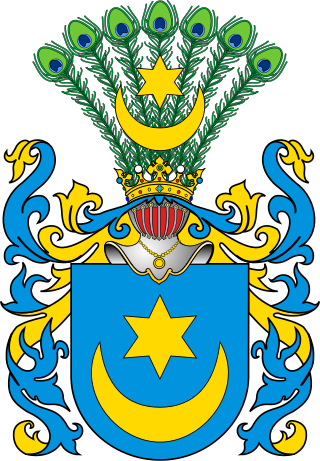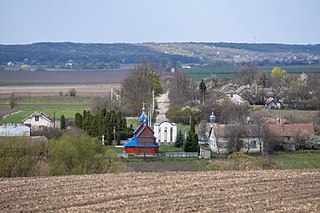
Nakło nad Notecią is a town in northern Poland on the river Noteć with 23,687 inhabitants (2007). It is the seat of Nakło County, and also of Gmina Nakło nad Notecią, situated in the Kuyavian-Pomeranian Voivodeship. It is located in the ethnocultural region of Krajna.

Bydgoszcz Canal is a canal, 24.7 km long, between the cities of Bydgoszcz and Nakło in Poland, connecting Vistula river with Oder river, through Brda and Noteć rivers. The level difference along the canal is regulated by 6 locks. The canal was built in 1772–1775, at the order of Frederick II, king of Prussia.

Stanislovas Goštautas was a member of the Lithuanian nobility and a high-ranking member of the Lithuanian administration. Born to Albertas Goštautas, the Voivode of Vilnius and Princess Sofia of Vereya, he was the last direct male descendant of the – once mighty – Goštautai family.
Lucim is a village in the administrative district of Gmina Koronowo, within Bydgoszcz County, Kuyavian-Pomeranian Voivodeship, in north-central Poland. It lies approximately 10 kilometres (6 mi) north-west of Koronowo and 32 km (20 mi) north of Bydgoszcz. It is located in the region of Krajna.
Sicienko is a village in Bydgoszcz County, Kuyavian-Pomeranian Voivodeship, in north-central Poland. It is the seat of the gmina called Gmina Sicienko. It lies 17 km (11 mi) north-west of Bydgoszcz.

Polichno is a village in the administrative district of Gmina Nakło nad Notecią, within Nakło County, Kuyavian-Pomeranian Voivodeship, in north-central Poland. It lies approximately 4 kilometres (2 mi) south-west of Nakło nad Notecią and 31 km (19 mi) west of Bydgoszcz. It is located in the ethnographic region of Pałuki.

Samoklęski Duże is a village in the administrative district of Gmina Szubin, within Nakło County, Kuyavian-Pomeranian Voivodeship, in north-central Poland. It lies approximately 9 kilometres (6 mi) north-west of Szubin, 10 km (6 mi) south-east of Nakło nad Notecią, and 21 km (13 mi) west of Bydgoszcz.
Samoklęski Małe is a village in the administrative district of Gmina Szubin, within Nakło County, Kuyavian-Pomeranian Voivodeship, in north-central Poland. It lies approximately 6 kilometres (4 mi) north of Szubin, 12 km (7 mi) south-east of Nakło nad Notecią, and 20 km (12 mi) west of Bydgoszcz.

Tur is a village in the administrative district of Gmina Szubin, within Nakło County, Kuyavian-Pomeranian Voivodeship, in north-central Poland. It lies approximately 8 kilometres (5 mi) north of Szubin, 12 km (7 mi) south-east of Nakło nad Notecią, and 19 km (12 mi) west of Bydgoszcz.
Dębionek is a village in the administrative district of Gmina Sadki, within Nakło County, Kuyavian-Pomeranian Voivodeship, in north-central Poland. It lies approximately 7 kilometres (4 mi) north of Sadki, 13 km (8 mi) north-west of Nakło nad Notecią, and 39 km (24 mi) west of Bydgoszcz.
Kraczki is a village in the administrative district of Gmina Sadki, within Nakło County, Kuyavian-Pomeranian Voivodeship, in north-central Poland. It lies approximately 6 kilometres (4 mi) north-west of Sadki, 16 km (10 mi) west of Nakło nad Notecią, and 43 km (27 mi) west of Bydgoszcz.
Radzicz is a village in rural Gmina Sadki, within Nakło County, Kuyavian-Pomeranian Voivodeship, in north-central Poland. It lies approximately 5.5 kilometres (3 mi) north-west of Sadki, 15 km (9 mi) north-west of Nakło nad Notecią, and 42 km (26 mi) west of Bydgoszcz.

Sadki is a village in Nakło County, Kuyavian-Pomeranian Voivodeship, in north-central Poland. It is the seat of the gmina called Gmina Sadki. It lies approximately 11 kilometres (7 mi) west of Nakło nad Notecią and 38 km (24 mi) west of Bydgoszcz.

Hutten-Czapski, or Graf von Hutten-Czapski, or simply Czapscy, or Czapski, is the name of an old Polish aristocratic family from Pomerania. Some branches were given the title of Count. Members of the family have contributed to Poland's political, cultural and military history. Some members of the family were first recorded serving as Prussian Baltic knights, their allegiance was to Poland.

The Błociszewski family - a Polish noble family with the coat of arms of Ostoja, belonging to the heraldic Clan Ostoja (Moscics), originating from Błociszewo in the former of Kościan district of Poznań voivodeship. From the Błociszewskis of the Ostoja CoA come: Brodnicki, Bytkowski, Gajewski, Lubiatowski, Ptaszkowski, Szczodrowki.

The Jerzykowski family - Polish noble family with the coat of arms of Ostoja, belonging to the heraldic Clan Ostoja (Moscics). The Jerzykowski family took their surname from the village of Jurzykowo, located in the former district of Gniezno in the province of Poznań. The Jerzykowski family was mentioned in the armorial of Bartosz Paprocki. The Baranowski of the Ostoja coat of arms come from the Jerzykowski family.

Shvaikivtsi is a village in Chortkiv Raion, Ternopil Oblast of Ukraine. It belongs to Zavodske settlement hromada, one of the hromadas of Ukraine. It is the administrative center of the former Shmankivchyky village council.











